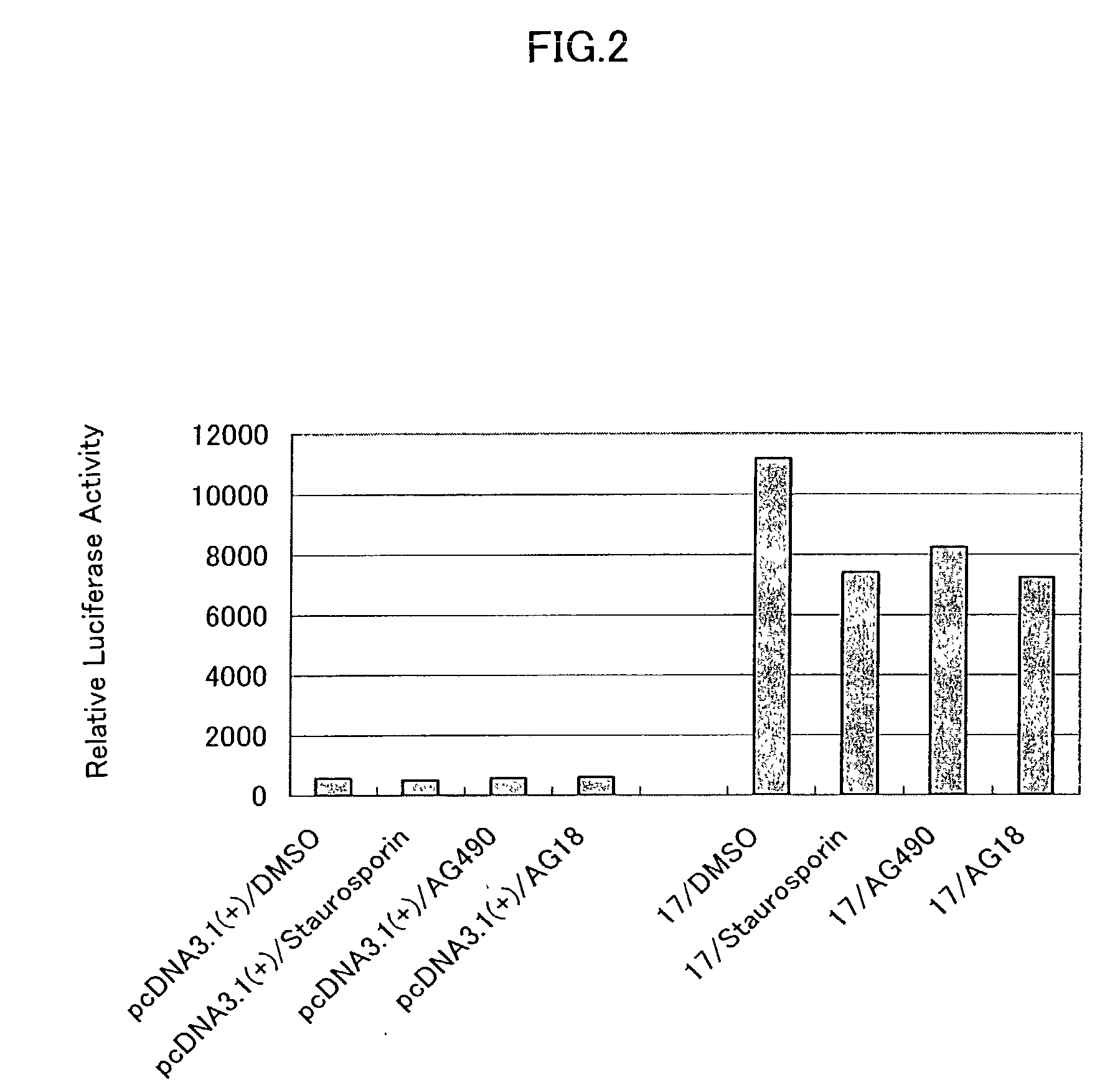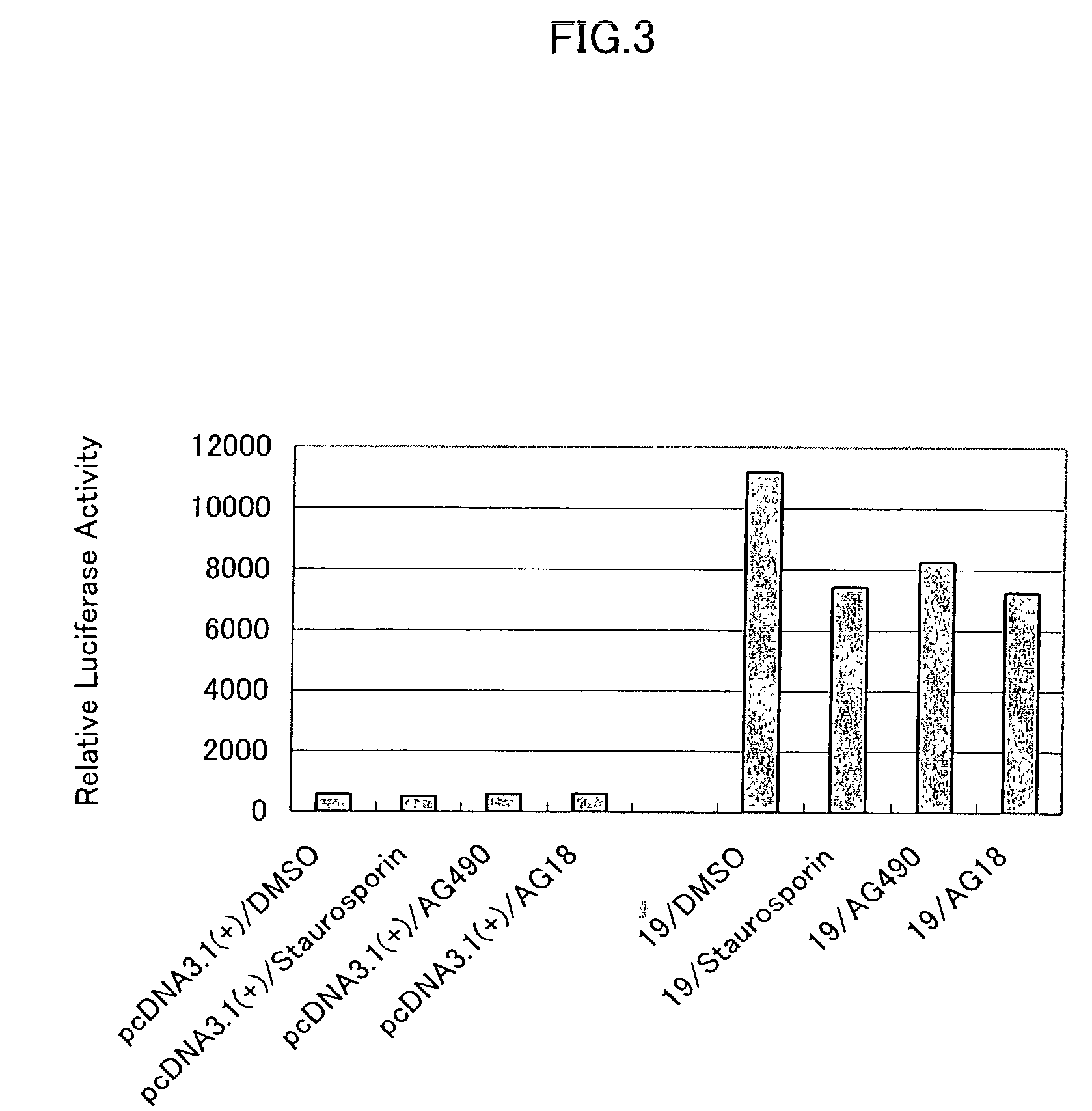STAT6 activation gene
a technology of activation gene and stat6, which is applied in the field of new genes and proteins, can solve problems such as difficulty in predicting their functions
- Summary
- Abstract
- Description
- Claims
- Application Information
AI Technical Summary
Benefits of technology
Problems solved by technology
Method used
Image
Examples
example 1
[0226] Construction of a Full-length cDNA Library Using the Oligo-capping Method
[0227] (1) Preparation of RNA from Human Lung Fibroblasts (Cryo NHLF)
[0228] Human lung fibroblasts (Cryo NHLF: purchased from Sanko Junyaku Co., Ltd.) were cultured according to the attached protocol. After repeating subculturing the cells to obtain fifty 10 cm dishes containing the resulting culture, the cells were recovered with a cell scraper. Then, total RNA was obtained from the recovered cells by using the RNA extraction reagent ISOGEN (purchased from NIPPON GENE) according to the manufacture's protocol. Then, poly A.sup.+ RNA was obtained from the total RNA by using an oligo-dT cellulose column according to Maniatis et al., supra.
[0229] (2) Construction of a Full-length cDNA Library by the Oligo-capping Method
[0230] A full-length cDNA library was constructed from the above poly A.sup.+ RNA by the oligo-capping method according to the method of Sugano S. et al. [e.g., Maruyama, K. & Sugano, S., Gen...
example 2
[0233] Cloning of DNA Capable of Promoting STAT6 Activation
[0234] (1) Screening of the cDNA Encoding the Protein Capable of Promoting STAT6 Activation
[0235] NIH3T3 cells (purchased from Dainippon Pharmaceutical) were grown to 1.times.10.sup.4 cells / well in a 96 well plate for cell culture for 24 hours at 37.degree. C. (in the presence of 5% CO.sub.2) using 10% FBS containing IMDM medium. Then, 100 ng of luciferase reporter plasmid N4.times.8-luc having a STAT6 response sequence and 2 .mu.l of the full-length cDNA prepared in above Example 1.(3) were cotransfected into the cells in a well using FuGENE 6 (purchased from Roche) according to the manufacturer's protocol. The luciferase reporter plasmid N4.times.8-luc having the STAT6 response sequence was constructed as follows. With reference to the oligonucleotide sequence to which an activated STAT6 binds specifically, found by Ohmori et al. [J. Immunol. 157, 2058-2065 (1996)], oligonucleotides having the following sequences were synt...
example 3
[0245] Screening Compounds Inhibiting Promotion of STAT6 Activity
[0246] NIH3T3 cells were seeded on 10% FBS containing IMDM medium in a 96-well cell culture plate to a final cell density of 1.times.10.sup.4 cells / 100 .mu.l / well, and cultured for 24 hours at 37.degree. C. in the presence of 5% CO.sub.2. Then, 30 ng of the plasmid containing the nucleotide encoding the STAT6 activation-promoting protein of SEQ ID NO: 3, 17, 19, 218, 432 or 472, or the nucleotide of SEQ ID NO: 64, and 100 ng of the luciferase reporter plasmid having the STAT6 response sequence were cotransfected into the cells in a well using FuGENE 6. After 48 hours, AG18, AG490, or staurosporin (purchased form CALBIOCHEM) known to be a protein kinase inhibitor was added to the culture to a final concentration of 20 .mu.M, 20 .mu.M, 30 .mu.M, respectively. After 30 min of culture at 37.degree. C., followed by 6 hours of culture with addition of mouse IL-4 to a final concentration of 1 ng / ml, the reporter activity was ...
PUM
| Property | Measurement | Unit |
|---|---|---|
| concentration | aaaaa | aaaaa |
| temperature | aaaaa | aaaaa |
| temperature | aaaaa | aaaaa |
Abstract
Description
Claims
Application Information
 Login to View More
Login to View More - R&D
- Intellectual Property
- Life Sciences
- Materials
- Tech Scout
- Unparalleled Data Quality
- Higher Quality Content
- 60% Fewer Hallucinations
Browse by: Latest US Patents, China's latest patents, Technical Efficacy Thesaurus, Application Domain, Technology Topic, Popular Technical Reports.
© 2025 PatSnap. All rights reserved.Legal|Privacy policy|Modern Slavery Act Transparency Statement|Sitemap|About US| Contact US: help@patsnap.com



